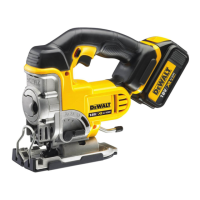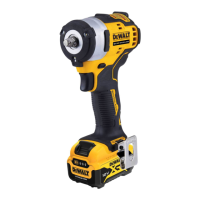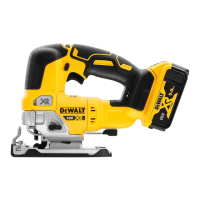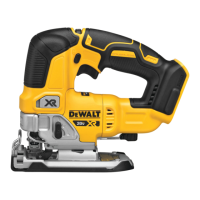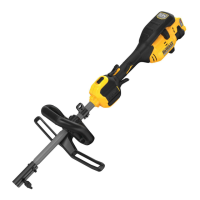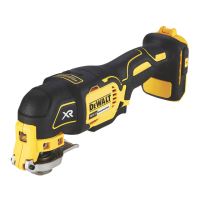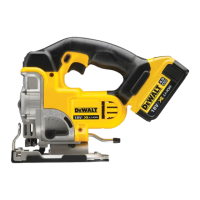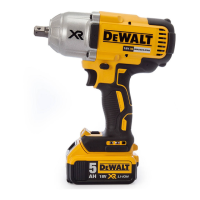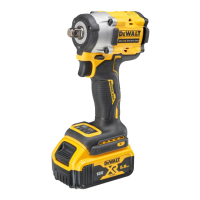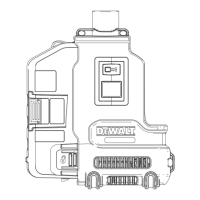10
ENGLISH
• This product is not intended for use by persons (including
children) suffering from diminished physical, sensory or
mental abilities; lack of experience, knowledge or skills
unless they are supervised by a person responsible for their
safety. Children should never be left alone with thisproduct.
ASSEMBLY AND ADJUSTMENTS
WARNING: To reduce the risk of serious personal
injury, turn tool off and disconnect battery pack
before making any adjustments or removing/
installing attachments or accessories. An accidental
start-up can causeinjury.
WARNING: Use only DeWALT battery packs andchargers.
Inserting and Removing the Battery Pack
from the Tool (Fig. B)
NOTE: Make sure your battery pack
6
is fullycharged.
To Install the Battery Pack into the Tool Handle
1. Align the battery pack
6
with the rails inside the tool’s
handle (Fig. B).
2. Slide it into the handle until the battery pack is firmly seated
in the tool and ensure that you hear the lock snap intoplace.
To Remove the Battery Pack from the Tool
1. Press the release button
7
and firmly pull the battery pack
out of the toolhandle.
2. Insert battery pack into the charger as described in the
charger section of thismanual.
Fuel Gauge Battery Packs (Fig. B)
Some DeWALT battery packs include a fuel gauge which
consists of three green LED lights that indicate the level of
charge remaining in the batterypack.
To actuate the fuel gauge, press and hold the fuel gauge
button
16
. A combination of the three green LED lights will
illuminate designating the level of charge left. When the level
of charge in the battery is below the usable limit, the fuel gauge
will not illuminate and the battery will need to berecharged.
NOTE: The fuel gauge is only an indication of the charge left on
the battery pack. It does not indicate tool functionality and is
subject to variation based on product components, temperature
and end-userapplication.
Side Handle (Fig.A)
WARNING: To reduce the risk of personal injury, ALWAYS
operate the tool with the side handle properly installed.
Failure to do so may result in the side handle slipping
during tool operation and subsequent loss of control. Hold
tool with both hands to maximizecontrol.
The side handle
(
5
)
clamps to the front of the gear case and
may be rotated 360˚ to permit right- or left-hand use. The side
handle must be tightened sufficiently to resist the twisting
action of the tool if the accessory binds or stalls. Be sure to grip
the side handle at the far end to control the tool during astall.
To loosen side handle, rotatecounterclockwise.
To Adjust the Depth Rod (Fig. C)
1. Push in and hold the depth rod release button
(
12
)
on the
side handle.
2. Move the depth rod
(
11
)
so the distance between the
end of the rod and the end of the bit equals the desired
drillingdepth.
3. Release the button to lock rod into position. When drilling
with the depth rod, stop when end of rod reaches surface
of material.
Belt Hook (Fig. D)
Optional Accessory
WARNING: To reduce the risk of serious personal
injury, ONLY use the tool’s belt hook to hang the
tool from a work belt. DO NOT use the belt hook
for tethering or securing the tool to a person or
object during use. DO NOT suspend tool overhead or
suspend objects from the belt hook.
WARNING: To reduce the risk of serious personal
injury, ensure the screw holding the belt hook
issecure.
IMPORTANT: When attaching or replacing the belt hook
(
14
)
,
use only the screw
(
18
)
that is provided. Be sure to securely
tighten the screw.
The belt hook can be be attached to either side of the tool using
only the screw provided, to accommodate left- or right- handed
users. If the hook is not desired at all, it can be removed from
the tool.
To move belt hook, remove the screw that holds the belt hook
in place then reassemble on the opposite side. Be sure to
securely tighten the screw.
Bit and Bit Holder
WARNING: Burn Hazard. ALWAYS wear gloves when
changing bits. Accessible metal parts on the tool and bits
may get extremely hot during operation. Small bits of
broken material may damage barehands.
The hammerdrill can be fitted with different bits depending on
the desired application. Use sharp drill bits only.
Bit Reccomendations
• For wood, use twist bits, spade bits, power auger bits or
hole saws.
• For metal, use high-speed steel twist drill bits or holesaws.
Use a cutting lubricant when drilling metals. The exceptions
are cast iron and brass which should be drilleddry.
• For masonry, such as brick, cement, cinder block, etc., use
carbide-tipped bits rated for percussiondrilling.
SDSPLUS Bit Holder (Fig.F)
NOTE: Special adapters are needed to use the SDSPLUS tool
holder with straight shank bits and hexagonal screwdriver bits.
Refer to Optional Accessories.
To insert a drill bit or other accessory:
1. Insert the shank of the bit about 19mm into SDSPLUS
toolholder.
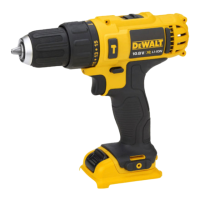
